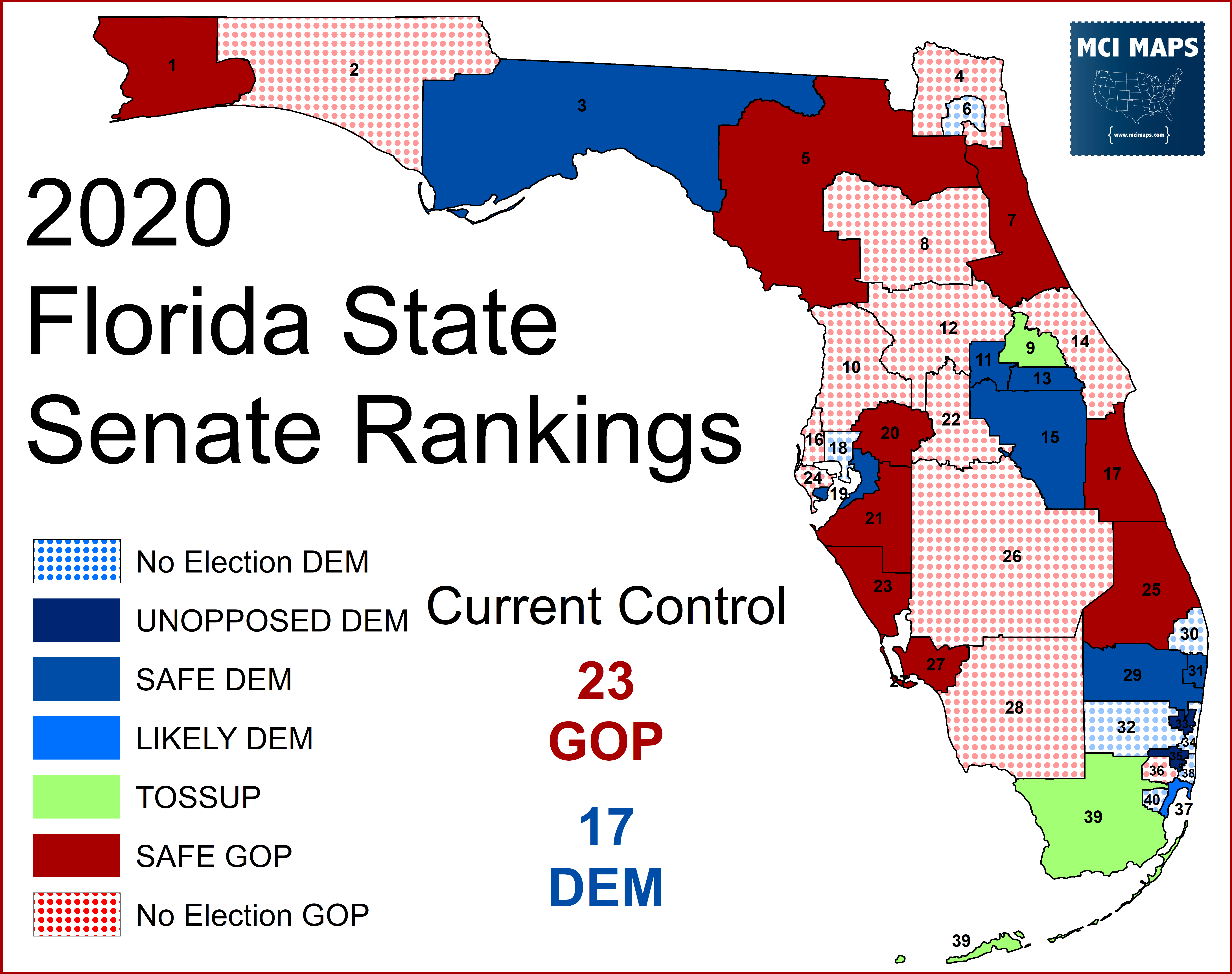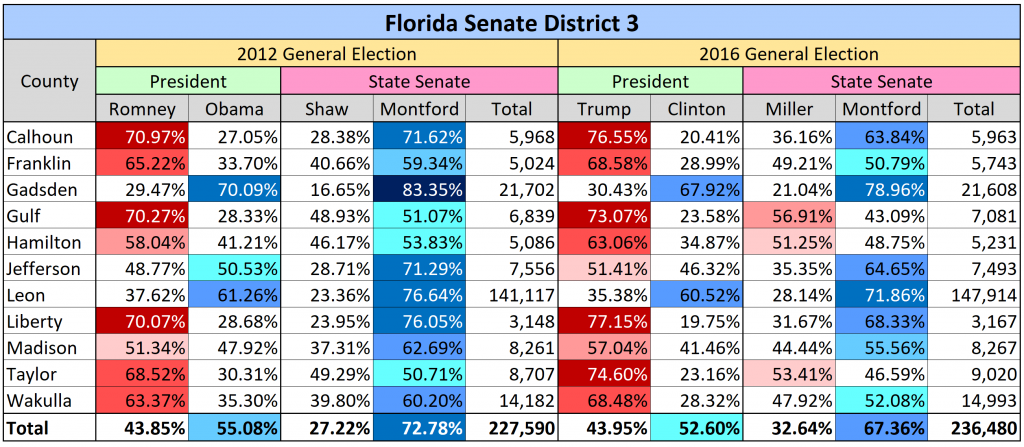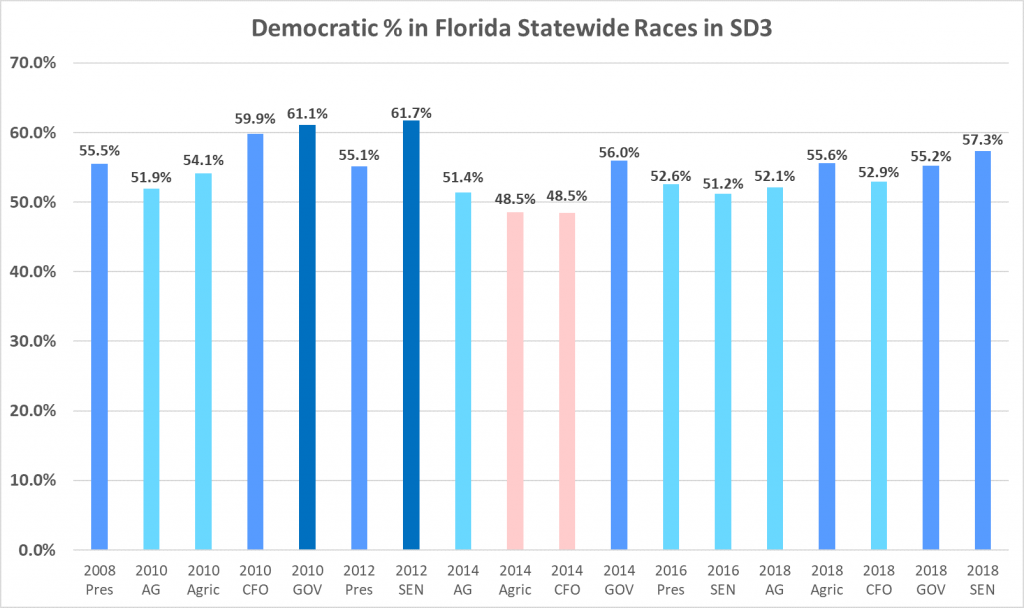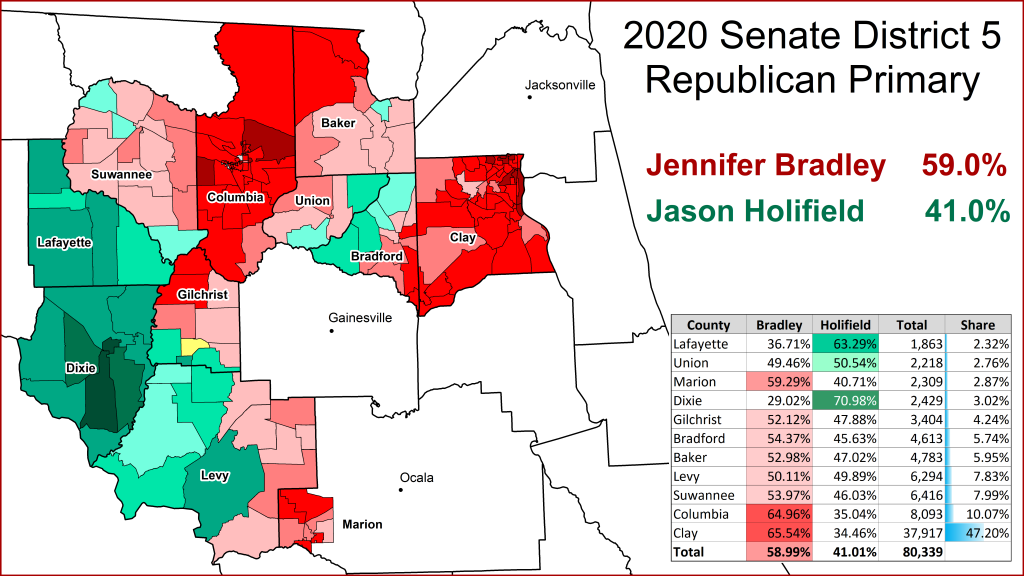The State Senate Map
This election cycle, just over half of Florida’s State Senate districts are up for election. Florida State Senators are elected to four years terms, with even numbered districts up in the midterms and odd numbered districts up in Presidential cycles. In addition to the odd districts, a special election for SD 20 is on the ballot this year. In the 2016 Presidential election, 21 seats backed Trump, while 19 backed Clinton. The map was put in place in 2016 after a mid-decade redistricting stemming from a lawsuit.
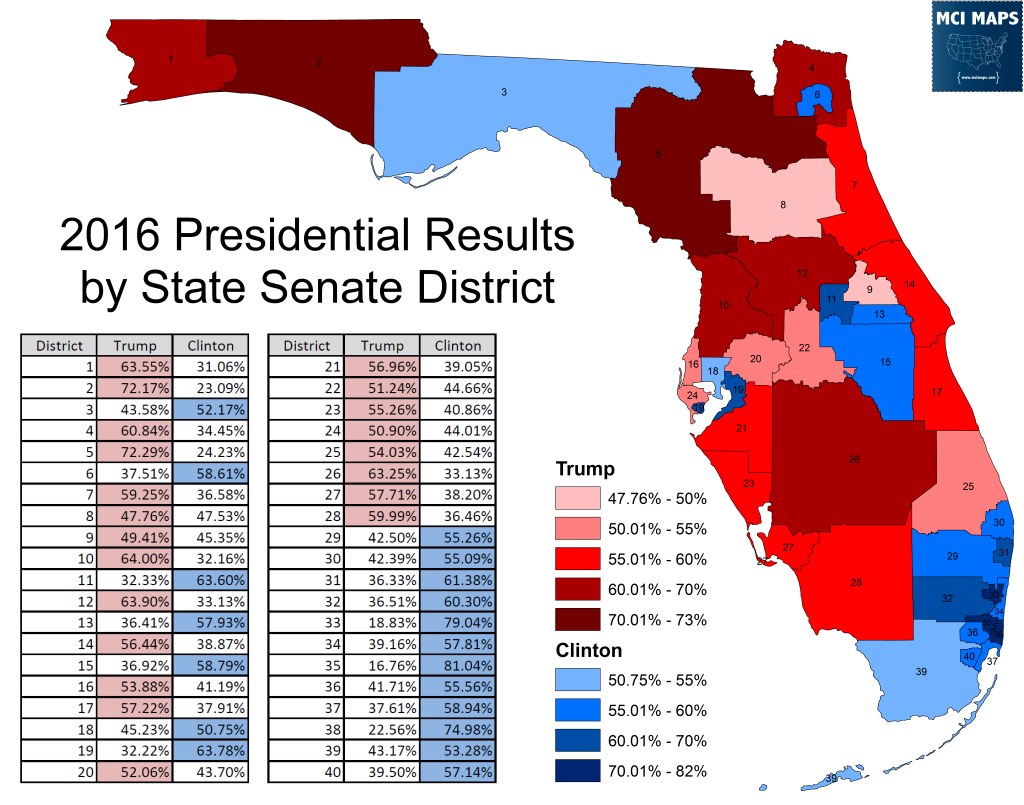
In the 2018 midterms, most districts voted straight R or D for all five statewide races, though some districts were very close in several contests.
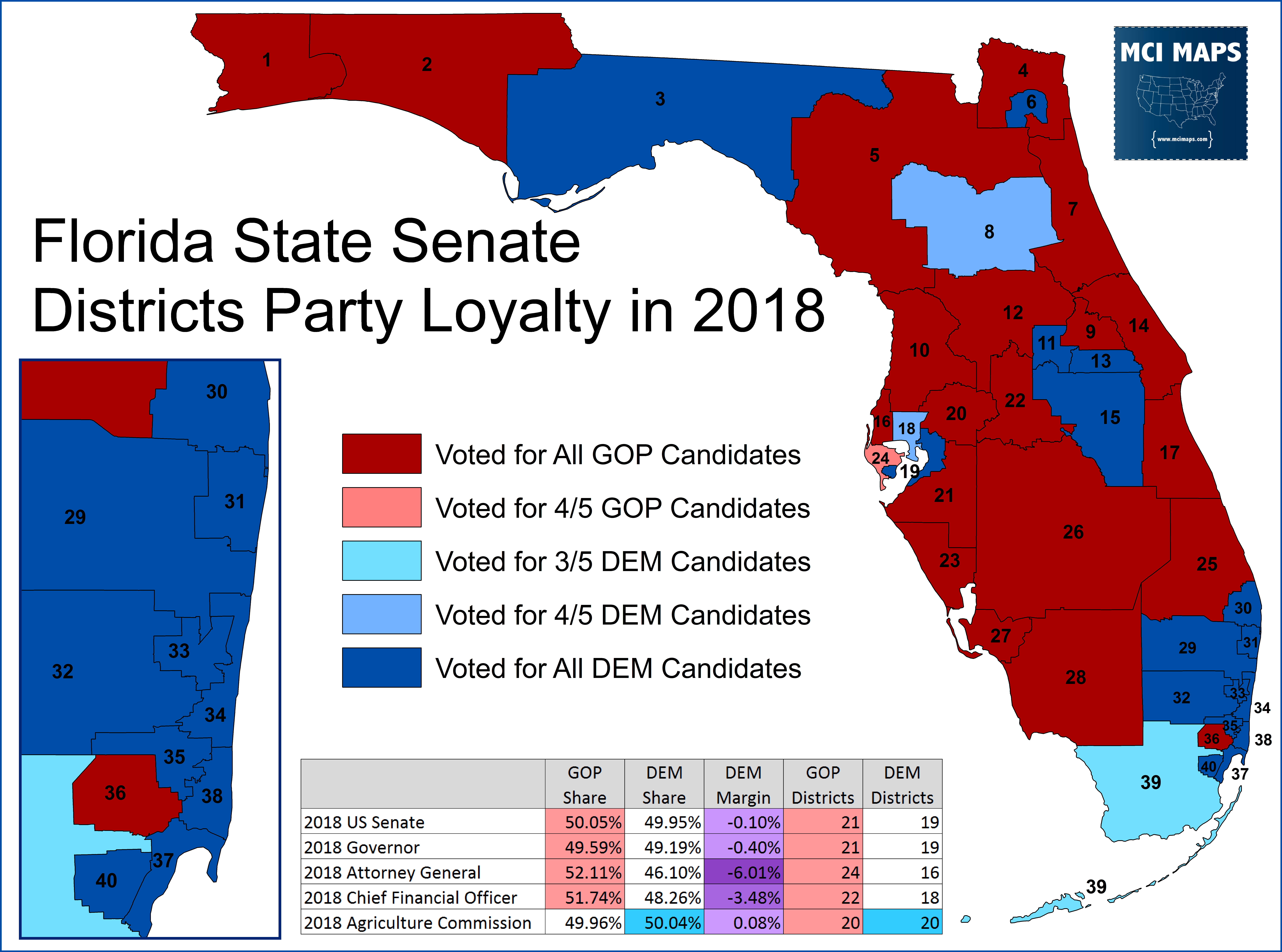
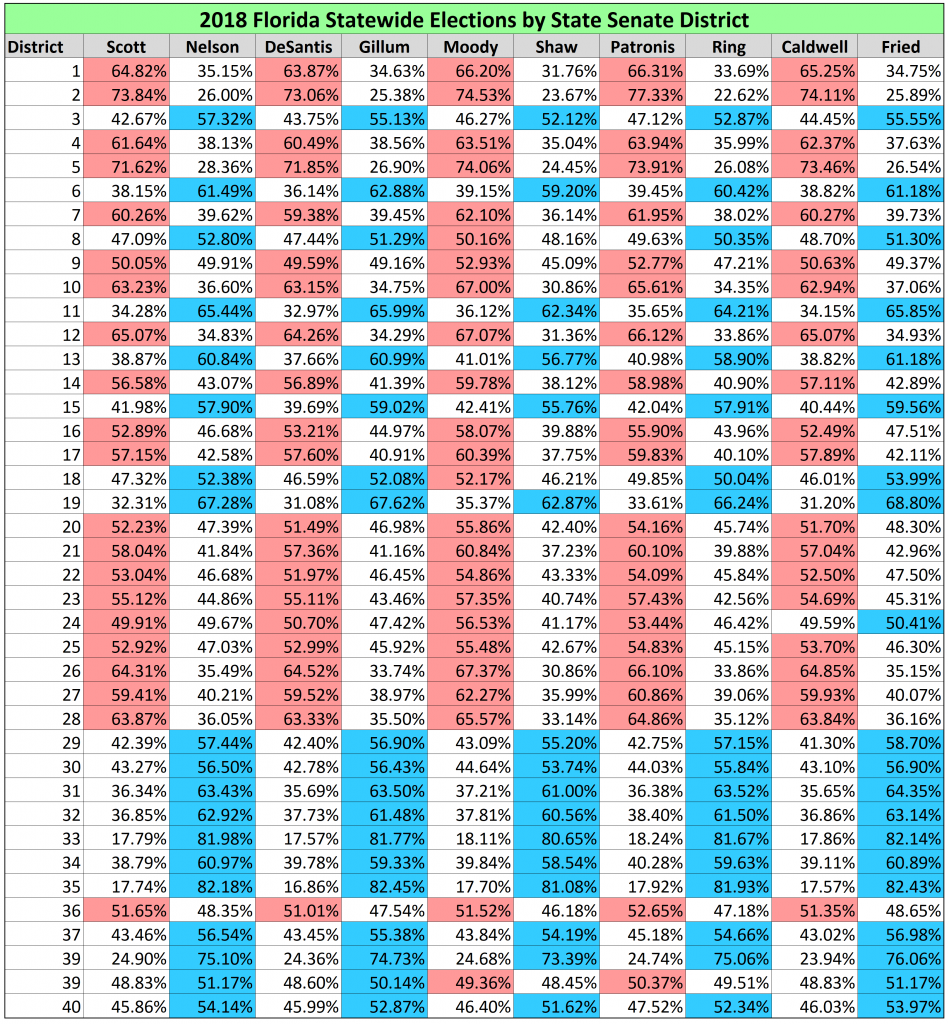
In the midterm, Democrats held their seats and gained SD 18. They now sit at 17 seats while the GOP sits at 23. With the final election before redistricting coming up, Democrats are hoping to make as many gains as possible to ensure a seat at the table. The trick for the Democrats is that the seats up this time offer only a few realistic pickup opportunities. However, Democrats have specific districts they are aiming for, while the GOP is working to defend what they hold and try to put the Democrats on defense in other areas as well.
Let’s look at each district on the ballot this year.
State Senate District 1
Senate District 1 is located on the far west end of Florida – including Escambia, Santa Rosa, and parts of Okaloosa counties. Other than a collection of African-American precincts in Pensacola, the district is blood red and general elections here are a formality. The seat voted for Trump by over 30 points and Republican Douglas Broxson has represented the seat since 2016.
Broxson won a contested primary in 2016 and since then has had little electoral concerns. He faced no primary this year and his lone opponent in the general is Democrat Karen Butler; who’s raised just $7,700. Broxson, meanwhile, sits on over $250,000 raised; granted he needs none of it to win.
Rating: Safe Republican
State Senate District 3
When the Florida State Senate went though its mid-decade redistricting, SD3 was the lone seat to see no changes. The district manages to split no counties; connecting the Tallahassee metro with the more rural counties that the surround it in the panhandle. The district is the last of the ancestral democratic seats; including places like Liberty County – which has never elected a local Republican to office despite being deep red for President. This ancestral democratic tradition allowed Bill Montford, a former educator and Leon Superintendent; born and raised in Calhoun county; to dominate in the district; winning 8/11 counties in 2016.
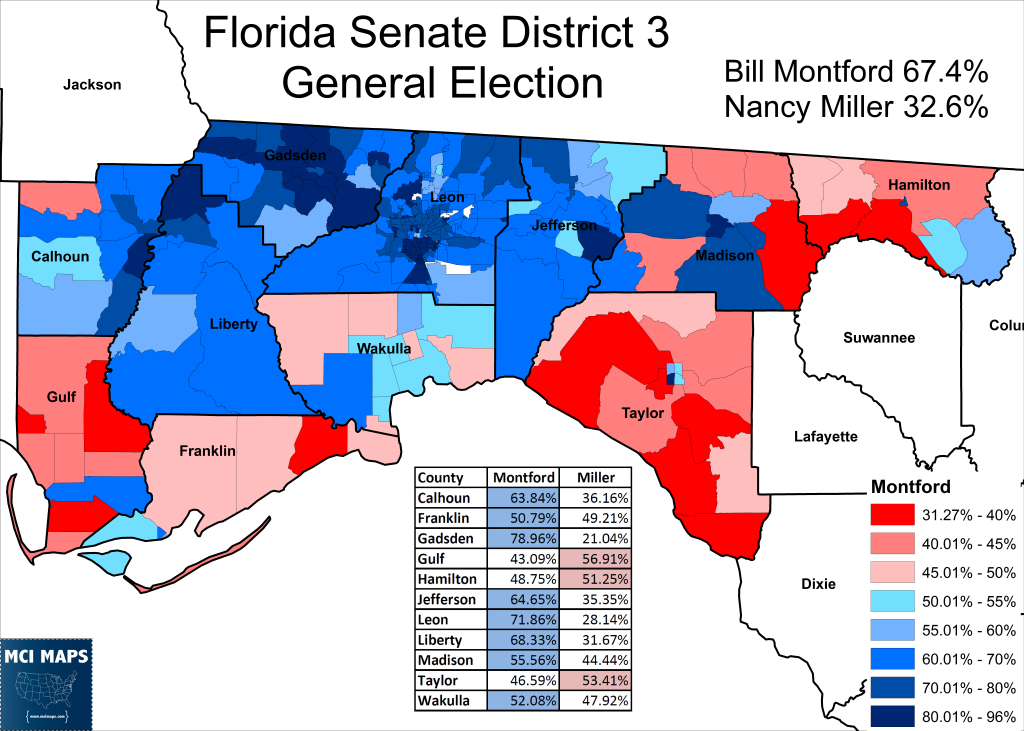
Despite the impressiveness of Montford’s win, the larger truth is many more counties in SD3 are decidedly more Republican. Only two of the eleven counties have been consistently Democratic for top-of-the-ticket races. However, the good news for Democrats is these include Leon (Tallahassee) and Gadsden, which combine to over 70% of the votes cast. As a result, Democrats up and down the ticket still control the seat. Hillary Clinton was decimated in many of the counties Montford won or came close in; but she still took the district by 9%.
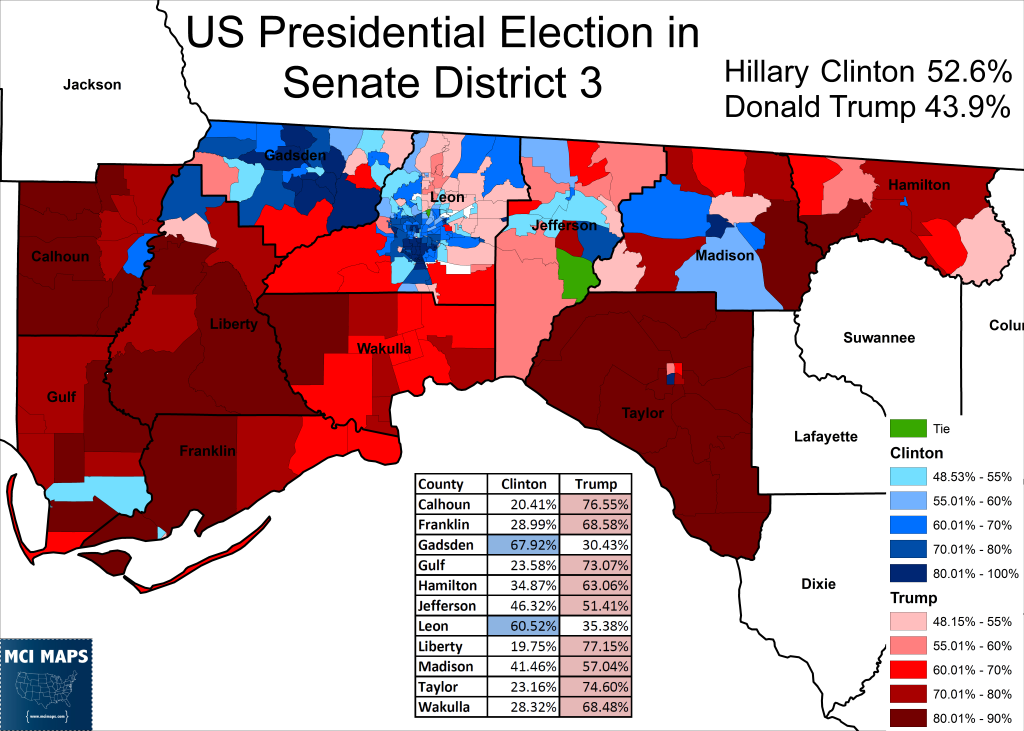
Montford over-performed Clinton the most in the white rural precincts in the west end of the district; the region he grew up in and where local Democratic strength was still strong.
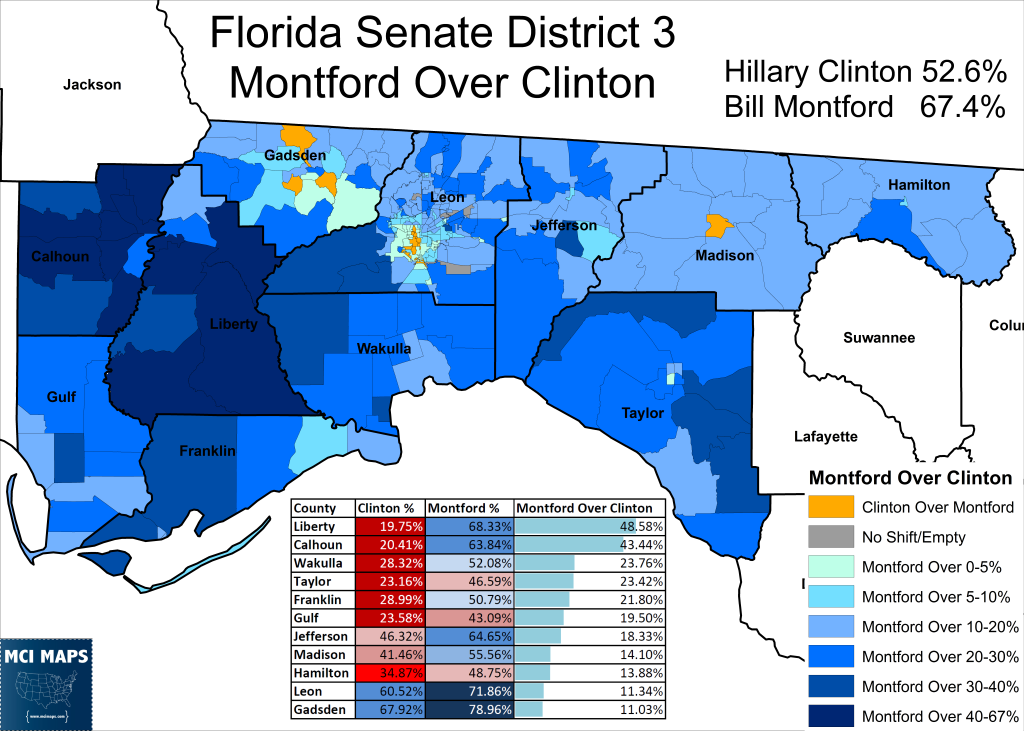
With Montford termed out of office, the Democrats have nominated Loranne Ausley, who has been a state representative for the Leon suburbs from 2000-2008 and 2016-2020. The Republicans recruited Marva Preston, an African-American retired cop in Wakulla county. The Republicans know that realistically they cannot win the district. Even if you dismiss Montford’s margin’s; other races show a pretty consistent Democratic edge. The biggest issue for Republicans is the dominance of Leon and Gadsden.
From 2008 to now, only two statewide races in Florida have seen the Republicans gain more votes than the democrats in SD3; the blowouts for CFO and Agriculture Commissioner in 2014.
Despite the Democratic advantage, the Republican party is bumping money into the race. Mailers and ads, paid for by the Florida Senate GOP committee, are touting Preston and Democrats are getting mailers that aim to cast Preston in a moderate light. Republicans hope Preston outperforms Trump in African American and overall Democratic precincts. The Democratic balance to that, however, is that Ausley comes from a long political and civic line in the region (going back to the 1930s). In the rural counties this lineage could aid Ausley in outperforming Biden outside of the urban core.
So why is the GOP pumping money into the district if a win is very unlikely? The answer is because they can afford to. The FL GOP groups are flush with money and their goal is simple; trick Democrats into diverting money into the district and distract them from their efforts to pick up other GOP-held seats. Since Democratic funds are not as massive, any money spent to defend the 3rd will harm efforts to gain other seats. For the Republicans, putting money into SD3 is a bid to trick the opposition.
The best news for Democrats in this regard is that Ausley herself is a strong fundraiser. She has taken in over $470,000 through her main political committee and has taken in additional hundreds of thousands through her “Florida 2020” committee as well. Preston has raised $117,000 so far; but much of the advertising SD3 voters are seeing is coming from the Florida GOP committees.
The GOP efforts are part of a chess game involving the Senate map. But these moves don’t change the fact that Ausley is a strong Democratic candidate and SD3 is too blue for their to be any real chance of an upset.
Rating: Safe Democratic
State Senate District 5
State Senate District 5 is one of the most Republican districts in Florida. Shaped like a “C” – the district connects deep-red Clay County (part of the Jacksonville suburbs) with assorted rural counties that loop around Gainesville. The district has been Represented by Rob Bradley, the powerful Appropriations Chair of the Florida Senate. Bradley is termed out of office and the GOP establishment rallied around Bradley’s wife, Jennifer. With GOP backing, Jennifer Bradley originally cleared the field of major Republican challengers. However, a late-breaking and nasty primary emerged in the summer when Jason Holifield, a former Dixie Commissioner, opted to challenge Bradley. As I wrote about in my Florida Primary Preview article, Holifield treated Jennifer as if she was just a way for her husband to remain in office. Jennifer, who amassed a warchest of over $500,000 in comparison to Holifield’s $100,000 in self-funding, hit Holifield for being a former Democrat. Dixie was one of the longtime ancestral democratic counties that was blue locally but red further up the ballot. In the end, Bradley won by a decent 18%.
The acrimony of the primary election won’t hinder GOP prospects in the general. The district is deep-dark-dark-dark red; voting for Trump by nearly 50%.
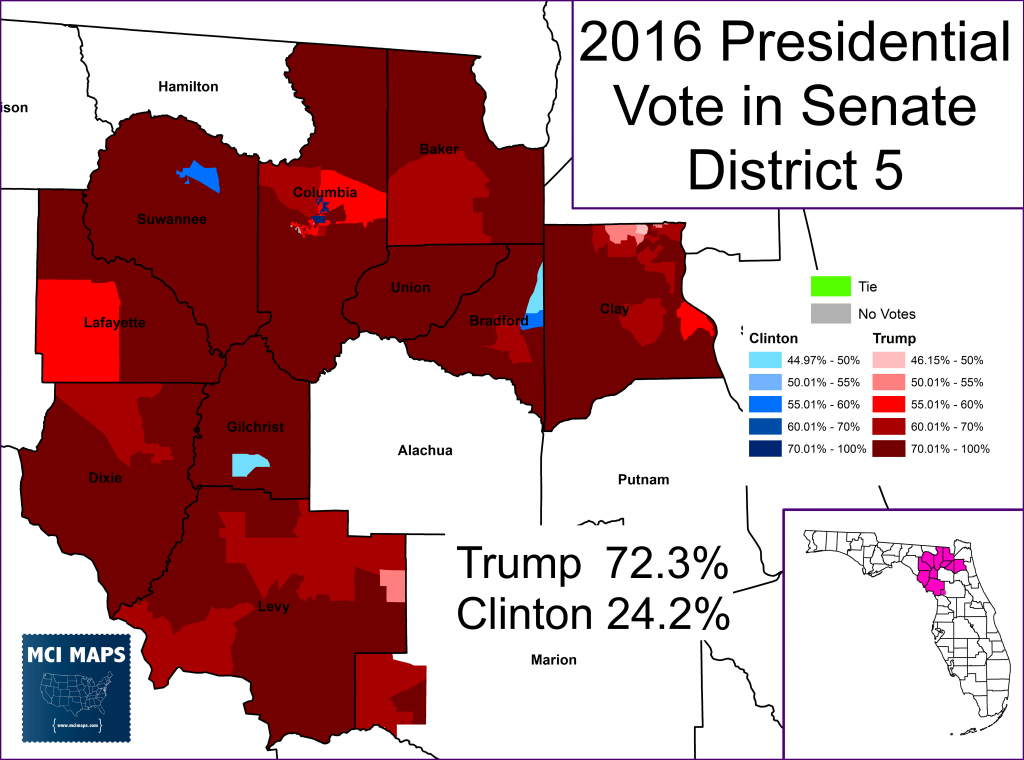
Bradley faces off against Democrat Melina Rayna Barratt; who has only raised $5,000.
Rating: Safe Republican
State Senate District 7
Republican Travis Hutson currently represents SD7, which covers the northeast coast; covering St Johns, Flagler, and parts of Volusia. The seat would have been potentially competitive at one time. but with the right-wing shifts in Flagler and Volusia, the district is now solidly conservative.
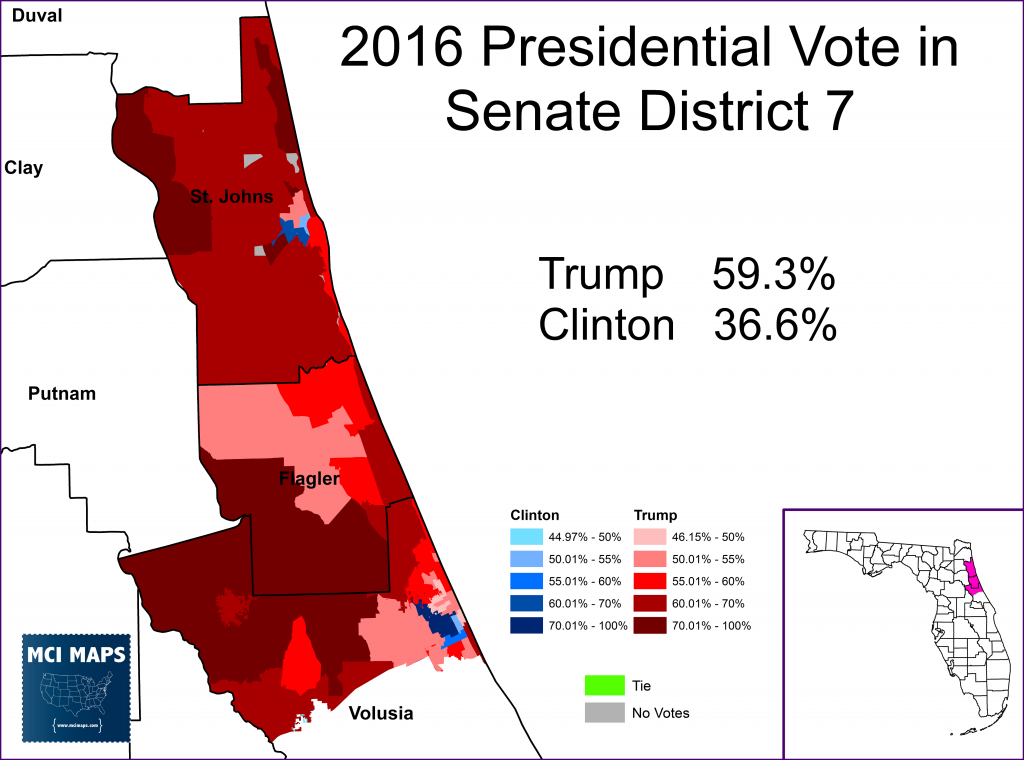
The only notable Democratic regions in the district are Daytona Beach and St Augustine; however they cannot overcome the rest of the district. Trump won the seat by over 20 points. Hutson is on course to cruise to re-election. The Senator has raised over $240,000 while Democrat Heather Hunter has raised just $9,100.
Rating: Safe Republican
State Senate District 9
Pre-2016, a district like SD9 would never be on Democratic radar as a pickup opportunity. Seminole County has long been a solid red suburb that sits north of Orlando. But like many suburbs across American, the mood is rapidly changing. Seminole nearly backed Hillary Clinton in 2016 and swung to team blue in the 2018 midterms. As a result, SD9, which covers all of Seminole and parts of Volusia went from being a Trump +4 county to a near even split in 2018.
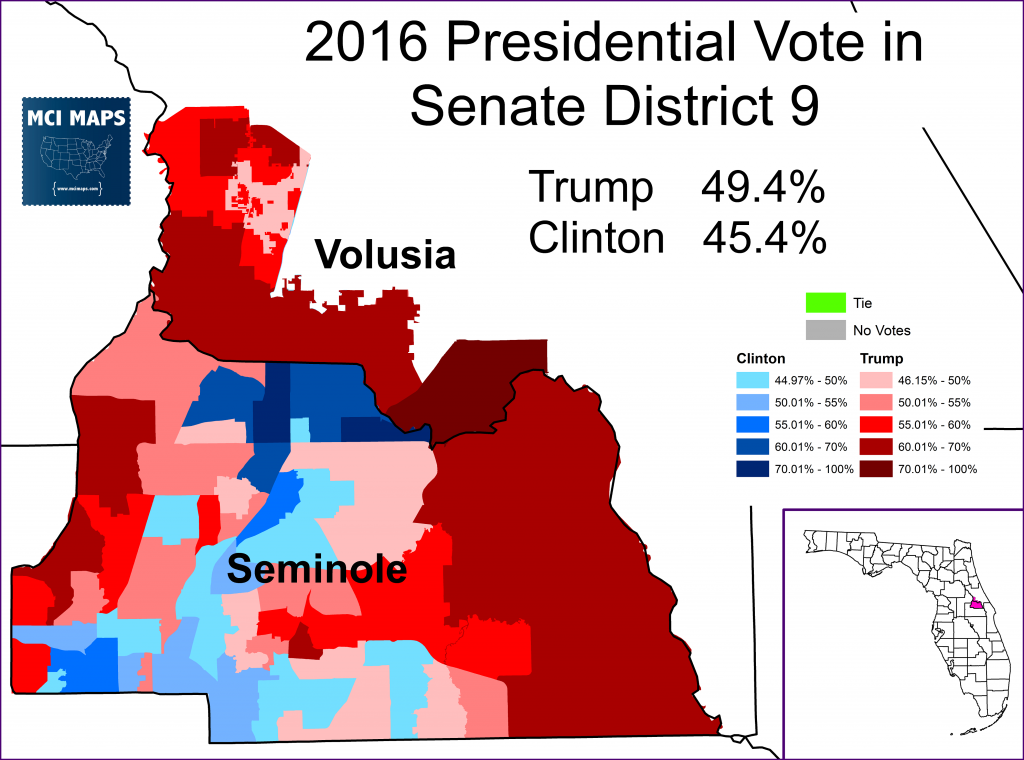
While statewide Republicans managed to hold SD9 in 2018, they did so by the narrowest of margins. Ron DeSantis only took SD9 by 0.4%.
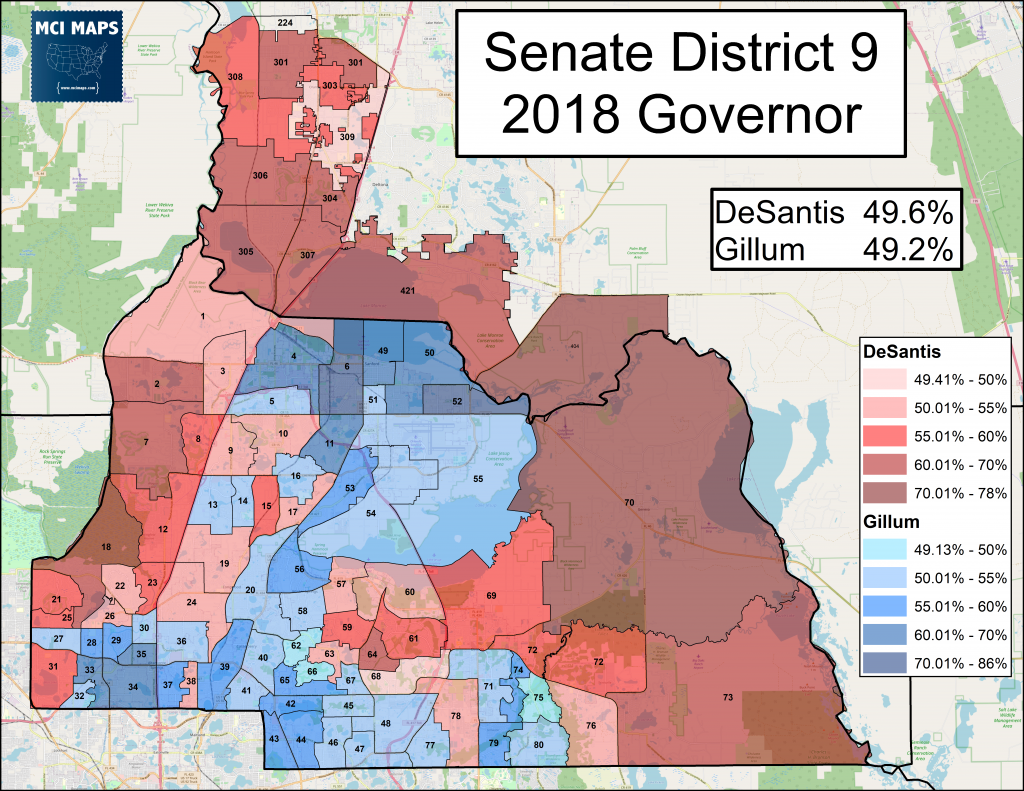
What has saved the GOP in the 9th is that the Volusia portion is much more steadily red. However, Seminole is very likely to back Biden this year and democrats are aiming for SD9 as one of their two best pickup opportunities for the cycle.
Democrats recruited labor lawyer Patricia Sigman for the race and she instantly began raising big money. The GOP meanwhile has long settled on former state rep Jason Brodeur; who’s been running for the seat since he was termed out of the house in 2018. The Republicans know this threat is real, as they worked to undermine Sigman in the Democratic primary by setting up a PAC that attacked her from the left. The attacks did not stop Sigman from easily winning her primary, however.
Polls show that Biden is current leading Trump in SD9. However, these suburbs can also split tickets to back local Rs, meaning this race is no lock for either side. How far this ticket splitting goes remains to be seen. It is notable that while the GOP has a near monopoly on local partisan offices in Seminole county, this cycle features several notable Democratic challengers. Four years ago most local races were all GOP affairs. Seminole is in the middle of political change up and down the ballot.
The Republicans will no doubt have the money advantage in this district, as it is reportedly all hands on deck by right-wing groups to hold the 9th. However, Brodeur himself has been on the bad end of press reports recently – the latest issue being he and his wife filing homestead exemptions (property tax breaks) in two counties for two houses (not allowed).
This race is going to be flushed with outside spending and is already heated and nasty.
Rating: Tossup
State Senate District 11
Located in Northwest Orange County, Senate District 11 is a solidly blue, African-American opportunity seat. While not majority African-American, it is over 50% black in a democratic primary and backed Clinton by over 30%. Freshman Senator Randolph Bracy is running for re-election.
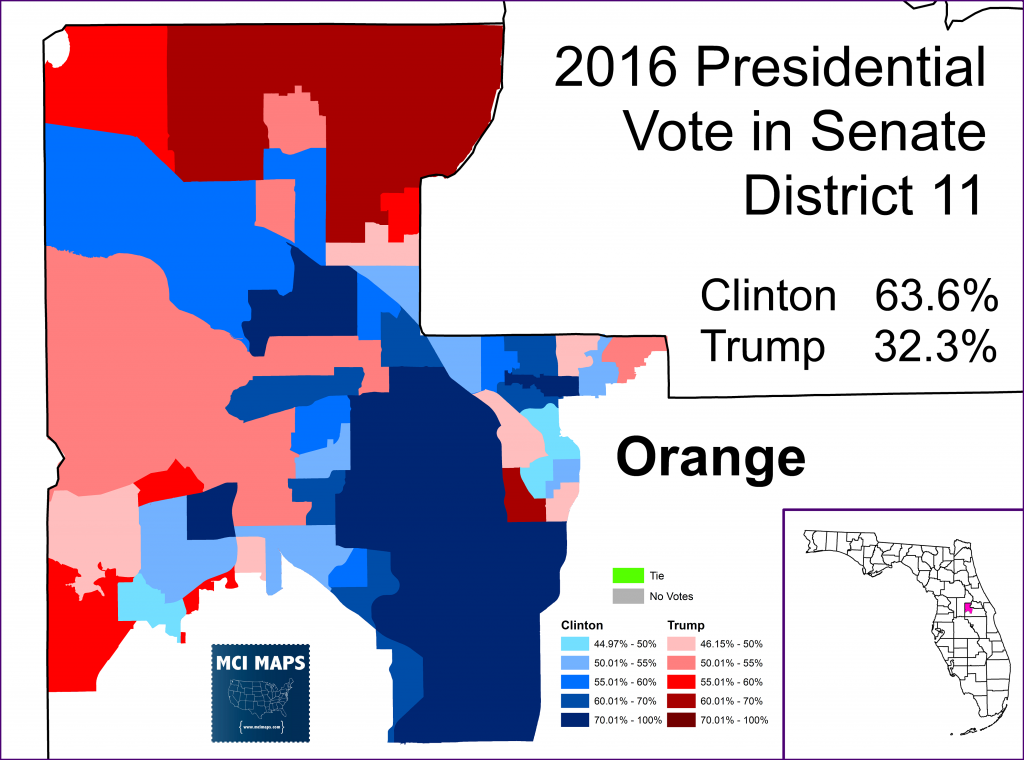
Bracy’s lone opponent is Republican Joshua Eli Adams, who hasn’t even cracked $5,000 in fundraising. Money aside, this is a dark blue seat and won’t be flipping.
Rating: Safe Democrat
State Senate District 13
Senate District 13 covers northeastern Orange County is a perfect example of the blue swing in the region. Despite representing many formerly GOP white suburbs, the district has seen much of its west end become solidly blue. Only a handful of pockets and the less-populated east end remain steadily Republican. Clinton won the district by 20% and Incumbent Linda Stewart beat back a well-funded challenger in 2016 by a 16% margin.

The district is also getting bluer as its Hispanic population continues to grow. Stewart is set to cruise to re-election this year, as her lone opponent, Republican Josh Anderson, has raised just $2,000 to pay the filing fee.
Rating: Safe Democrat
State Senate District 15
Senate District 15 is an Hispanic district located in Osceola county and southern Orange. 47% of its voters are Hispanic and as a result the seat is solidly Democratic, giving Clinton a 22% margin in 2016. Democrat Victor Torres won this seat in 2016 and it is far off the list of Republican targets.

Just a few cycles ago, Republicans had more local Republicans who could compete in the area. Republicans held a majority on the Osceola commission until 2014 – where they were swept out by Democrats. All local republicans focus on the more conservative HD42. As such, no major candidate emerged for the Republicans. Louis Minnis is the GOP nominee and has not cracked $5,000 in fundraising and has no real campaign.
Rating: Safe Democrat
State Senate District 17
District 17 covers Indian River and the southern half of Brevard County. The district is solidly Republican, voting for Trump by 20%.
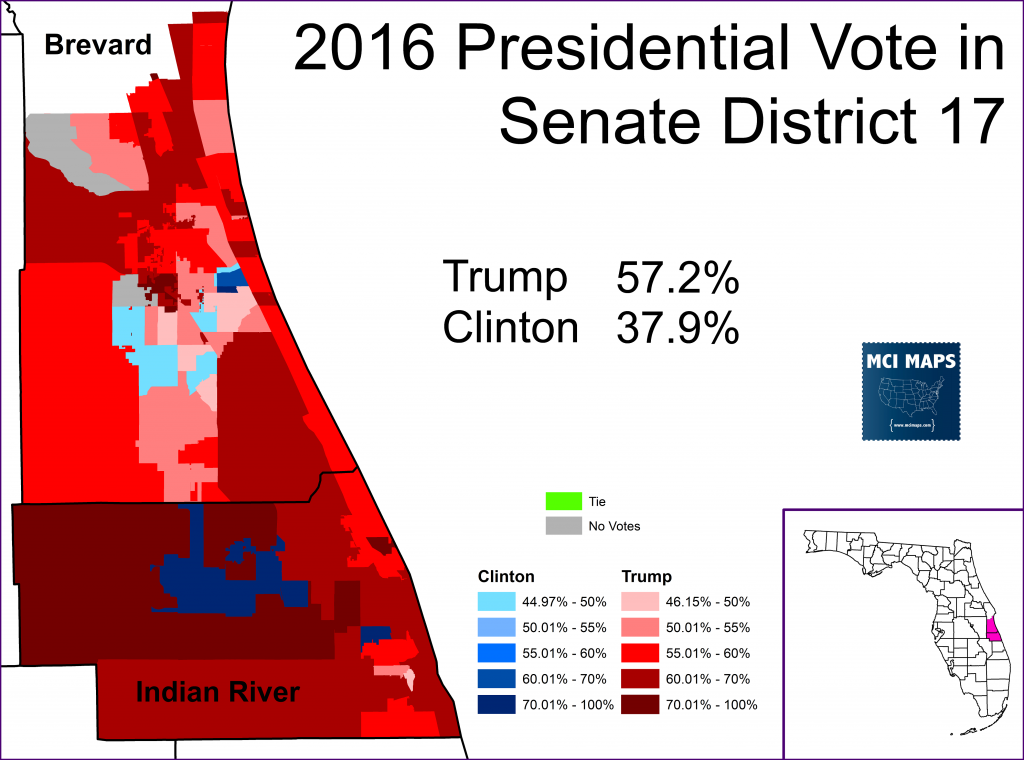
Incumbent Republican Debbie Mayfield is a lock for re-election. She has taken in over $400,000 while Democrat Scot Fretwell has only raised $6,800.
Rating: Safe Republican
State Senate District 19
In 2016, SD19 was the site of a major battle. This African-American access seat, which links African-Americans on both sides of the Tampa Bay, is solidly Democratic. In 2016, the seat saw four candidates, three off them state house members, fight in ‘The Battle of the Bay.” The contest saw Darryl Rouson pull off a narrow win by consolidating his base in Pinellas while Ed Narain and Betty Reid split their Hillsborough base.
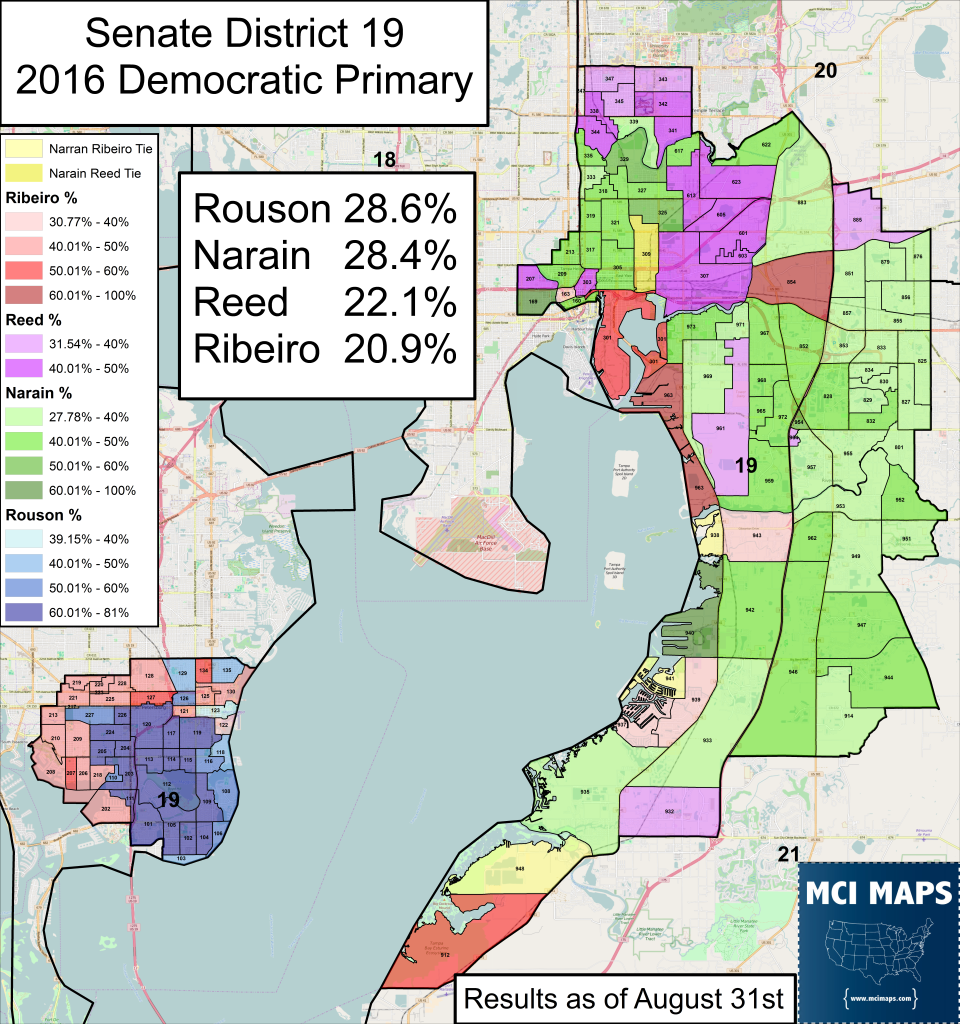
The election of Rouson caused concern for liberals. Rouson has been a more conservative Democratic in the state house. However, for his four years in the Senate, Rouson has largely been more in the Democratic camp and generated less controversy than his house days. As such, talks of a primary faded and Rouson saw no challenger emerge this year. His lone opponent is NPA candidate Christina Paylan; who has self-funded $40,000. This wont matter, however, in a seat where Clinton won the district by 30%.
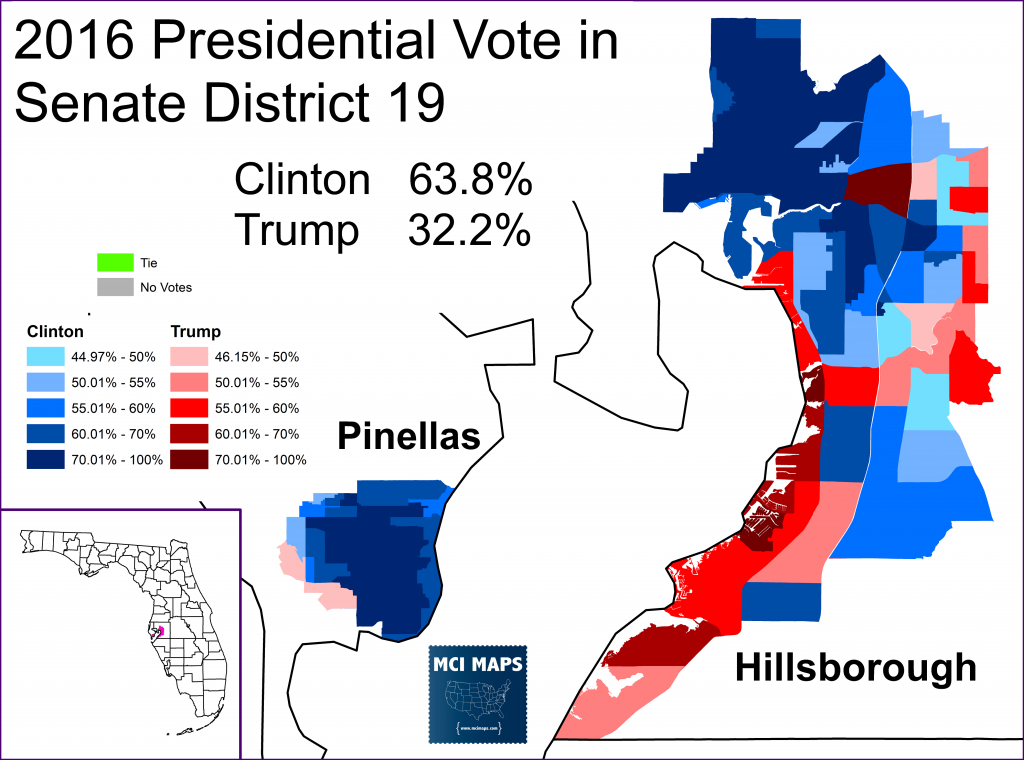
Rouson had a tough fight to get to the Senate four years ago. This time, his path to holding his seat is a lock.
Rating: Safe Democrat
State Senate District 20
State Senate district 20 is a modest GOP seat that takes from three counties. It takes in Southeastern Pasco, Northeastern Hillsborough, and Northwest Polk. The seat is held by Incumbent Tom Lee, a former Senate President and longtime politician from the region. Lee was re-elected in 2018, but opted to leave his term early; triggering a special election for this year.
The district hosts a strong democratic block of votes around the New Tampa, Temple Terrace, and the University of South Florida. The swing of rural communities to the right made the district more GOP-friendly. Gillum and Nelson both lost the district by the 4% to 5% range.
Lee’s resignation sparked a short rush by Democrats to recruit a strong challenger. Democrats aimed to recruit Alex Sink, who had carried the district in her 2010 Gubernatorial Election. However, internal polls showed Sink still solidly down to GOP nominee, former State Rep Danny Burgess. Democratic interest in seat dropped at this point and and 2018 Democratic nominee Kathy Lewis wound up being the only democrat to file. She has raised $44,000 while Burgess sits on hundreds of thousands between assorted committees and GOP support.
Lewis lost her campaign to in 2018 by 7.5%, under-performing the top of the ticket by about 3%, while Lee barely campaigned. That is not the case this time, as Burgess is raising and spending hundreds of thousands of dollars, including on broadcast TV ads in the district. However, besides a small in-kind of polling at the beginning of the campaign and one for consulting last month, the Senate Republican campaign arm has largely ignored the race, clearly indicating they believe the seat to not be in serious play.
While the district isn’t a deep red seat, its consistent voting to the right of the state has led to a candidate match-up that is decidedly lopsided toward the GOP.
Rating: Safe Republican
State Senate District 21
Senate President Bill Galvano is termed out of SD 21, which is covers the deep-red portions of Hillsborough county and solid-red Manatee county. The district gave Trump a 17% win in 2016.
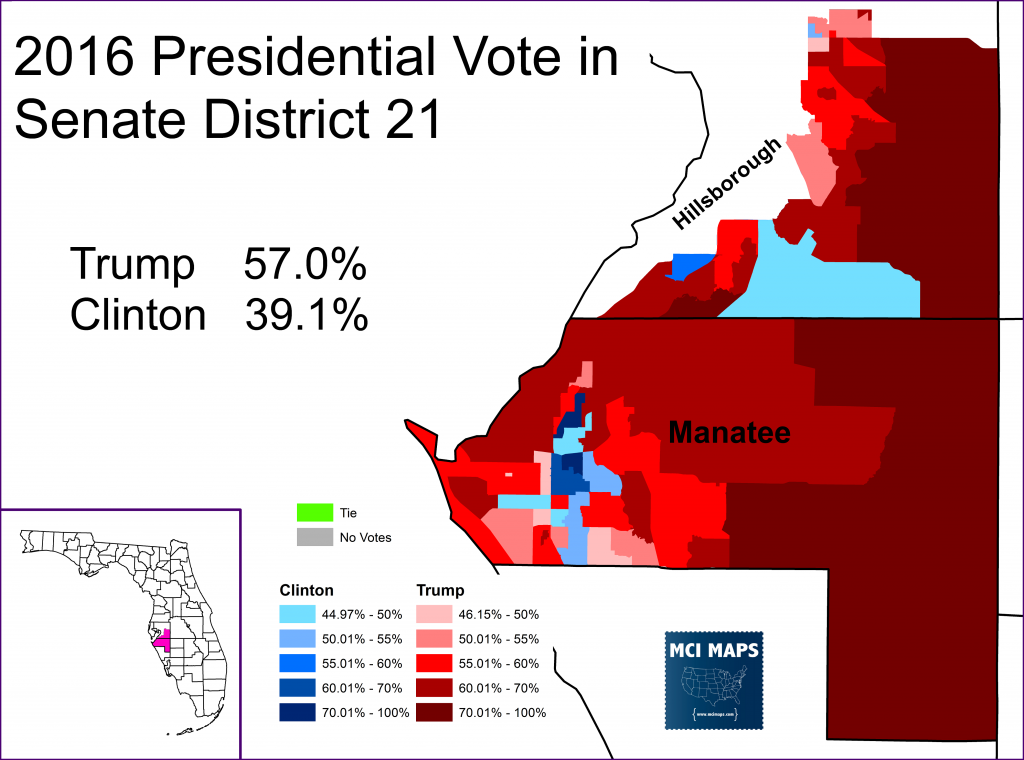
Former GOP State Rep Jim Boyd cleared the field and easily won the GOP primary back in August. His Democratic opponent is Anthony Eldon, who has only raised enough to pay the filing fee.
Rating: Safe Republican
State Senate District 23
SD 23 is based out of Sarasota County and includes western Charlotte. The seat includes Democratic pockets in Northern Sarasota and hosts House District 72, which Democrats picked up in a special election in early 2018 and narrowly held in the November midterm. However, outside that bright spot for Democrats is a very conservative block of voters further to the south. The district was solid for Trump, going to him by a 15% margin.
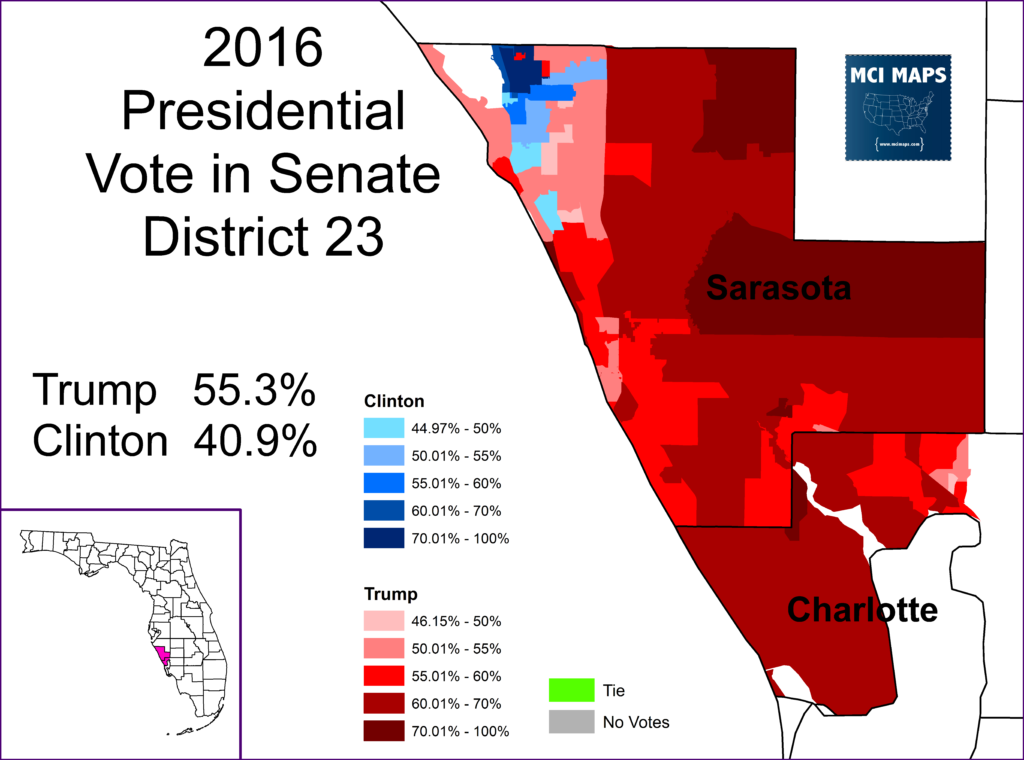
The district was also on the ballot in a special election in 2018. Despite late breaking polls that seemed to indicate a closer-than-expected race, GOP nominee Joe Gruters won a solid 56% of the vote. This go around, no one expects the district to be competitive. Democratic nominee Katherine Norman has only raised $7,000 while Gruters has un-ending cash available. Democratic focus in the area is on holding HD 72.
Rating: Safe Republican
State Senate District 25
District 25 includes all of St. Lucie County, Martin County, and some of Northern Palm Beach. By far the largest block of votes in the district is St Lucie and Martin. St Lucie took a strong swing to the right in 2016, going from a reliable blue county to a Trump county. The swing was thanks to St Lucie’s large white-working-class block of votes. This cause the seat to go from Romney +3.5 to Trump +11.
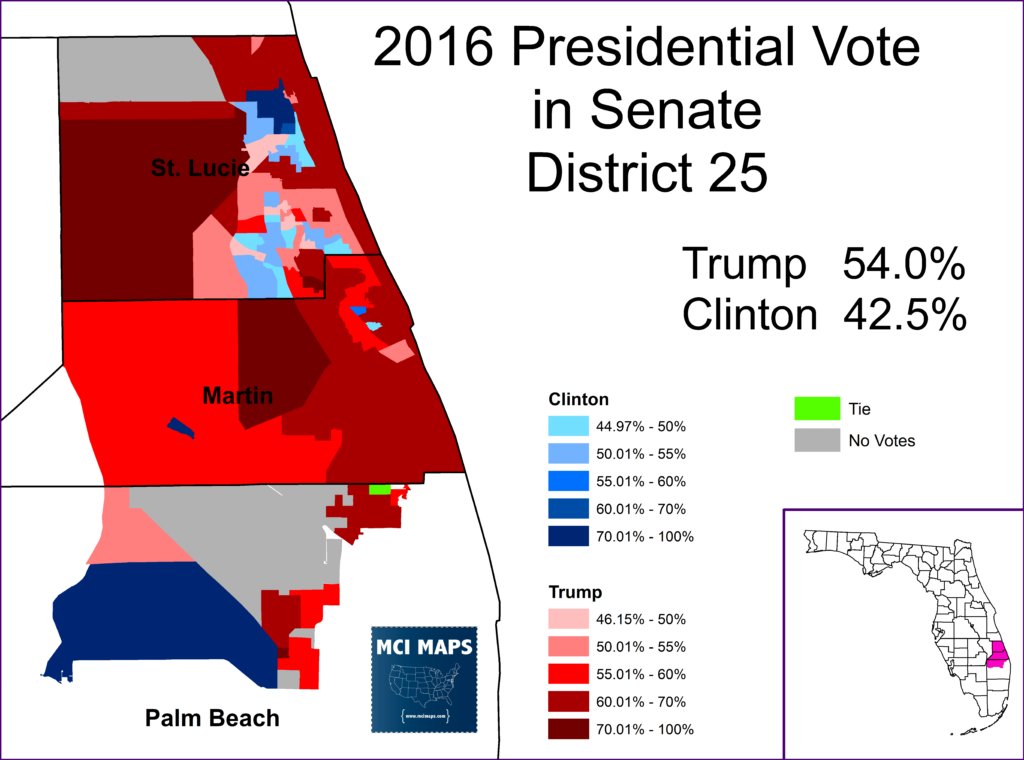
In 2018, as St Lucie went back to the blue column, the seat swung back a bit to the left. The seat was still firmly in the red column, however, backing Scott by 6% and DeSantis by 7%. That same day, a special election for SD25 (trigger by Joe Negron leaving early) was won by Republican Gayle Harrell by 9%. Harrell beat back a spirited challenge from Democratic physician Robert Levy, who self-funded over six-figures for his bid.
The loss in 2018 killed any interest from democrats in trying to take the seat again; especially has its expected to still back Trump. This cycles’ SD25 nominee Corinna Balderramos Robinson has only raised $15,000 while Harrell sits on over $300,000.
Rating: Safe Republican
State Senate District 27
SD27, which covers much of Lee County, is a solidly red district who’s only solidly Democratic block is Fort Meyers. The district already saw a vicious and expensive Republican primary. That primary saw State Rep Ray Rodrigues easily vanquish more moderate state rep Heather Fitzenhagen. Rodrigues now goes on to the general in a district that Trump won by 19%.
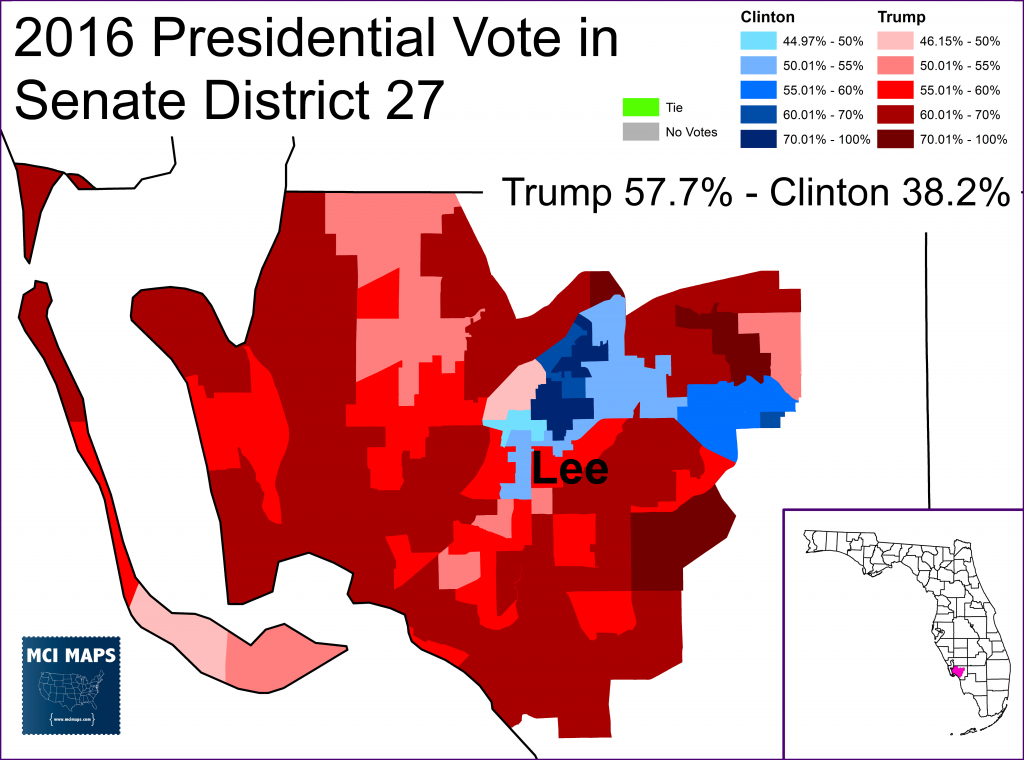
With the primary over, there is little for the GOP to worry about in November. The democratic nominee is Rachel Brown, who has only taken in $10,000.
Rating: Safe Republican
State Senate District 29
SD39 is a sprawling district that links NW Broward, southeast Palm Beach, Wellington, and agriculture communities along Lake Okeechobee (known as “The Glades”). The seat has been represented by Democrat Kevin Rader; who announced earlier this year that he will not run for re-election.
The big contest for SD29 has already taken place. The Democratic primary saw a face-off between Democratic State Rep Tina Polsky and former State Rep Irv Slosberg. Polsky’s HD81 district represented the western end of the district while Slosberg’s old district was right next door. Slosberg had left the seat in 2016 to run for State Senate District 31, which he lost to Jeff Clemens.
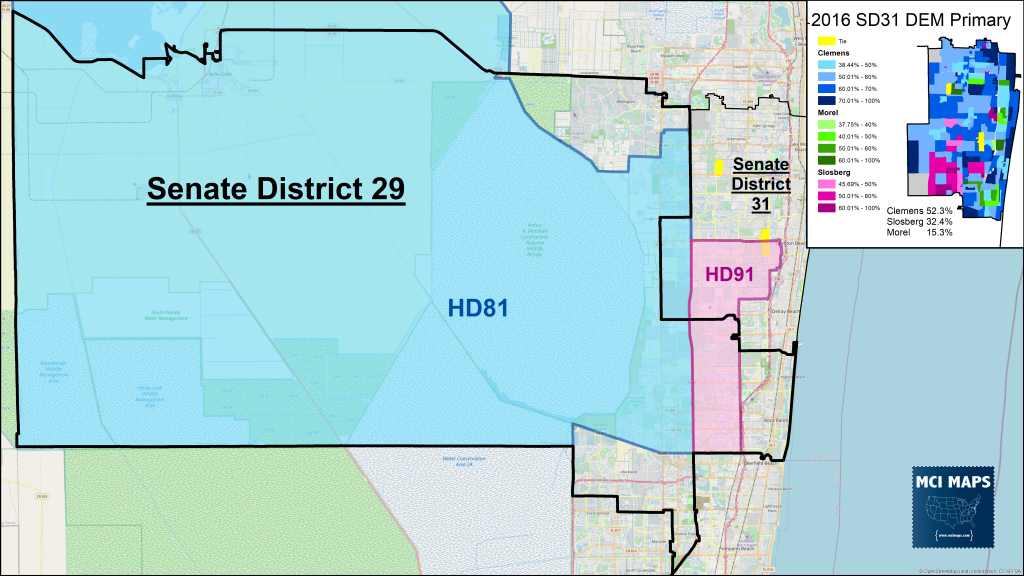
The 2016 primary had seen Slosberg self-fund up to $1.7 million from his personal fortune. This primary saw similar spending levels of $1.5 million. Polsky, meanwhile, raised hundreds of thousands and had the backing of Florida Democratic leader and many democratic-aligned organizations. The race was expensive and nasty. I wrote more about the dynamics of this primary in my primary preview article. In the end, Slosberg’s self-funding came to nothing, as he handily lost the primary to Polsky.
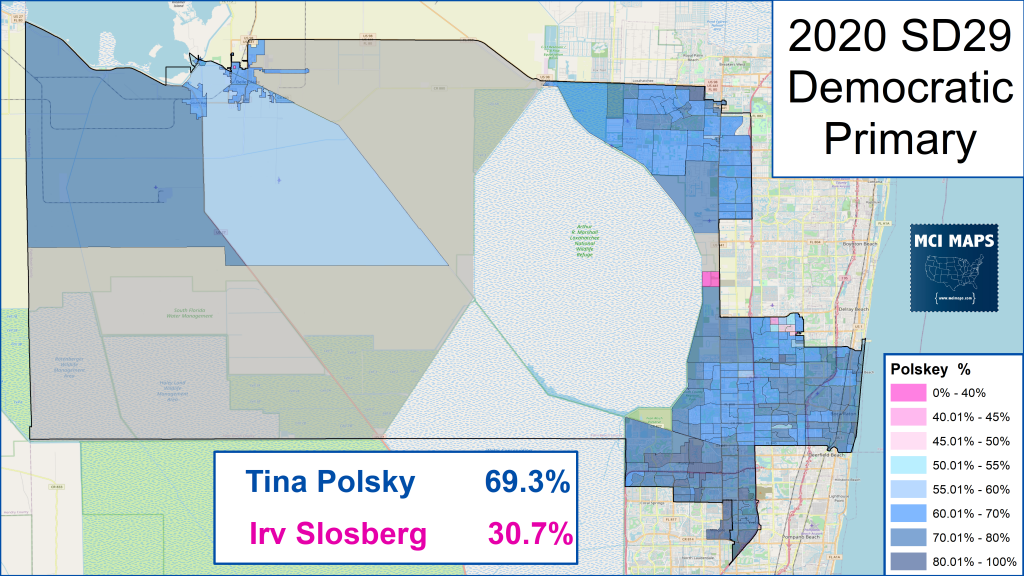
Polsky is now the Democratic nominee. Despite the expensive and nasty primary, Polsky emerges as a solid favorite to take the seat in November. In a general election, the district is solidly Democratic; giving Clinton a 13% margin in 2016.
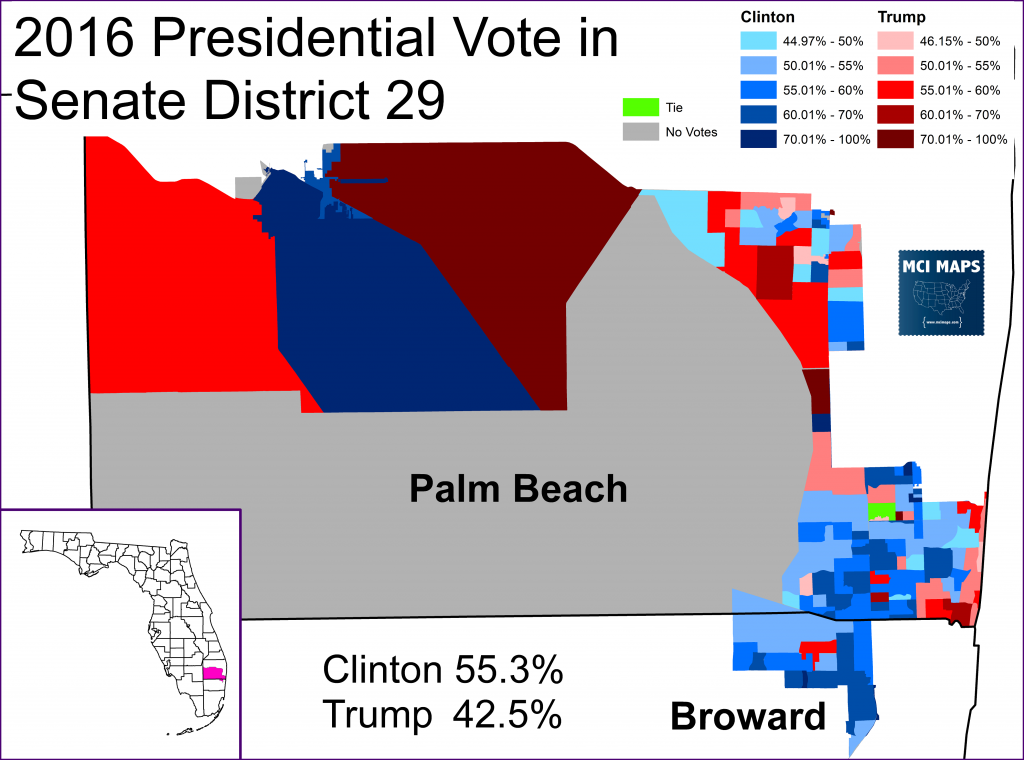
Polsky’s Republican opponent is Brian Norton, who has raised $30,000 and self-funded another 30 grand. That won’t be nearly enough to topple Polsky is a seat that Trump is destined to lose by double digits.
Rating: Safe Democrat
State Senate District 31
SD31 is located in the heart of Palm Beach County; sitting below West Palm Beach and including cities like Delray or Boynton Beach. The district is solidly Democratic, giving Clinton a 25% margin.
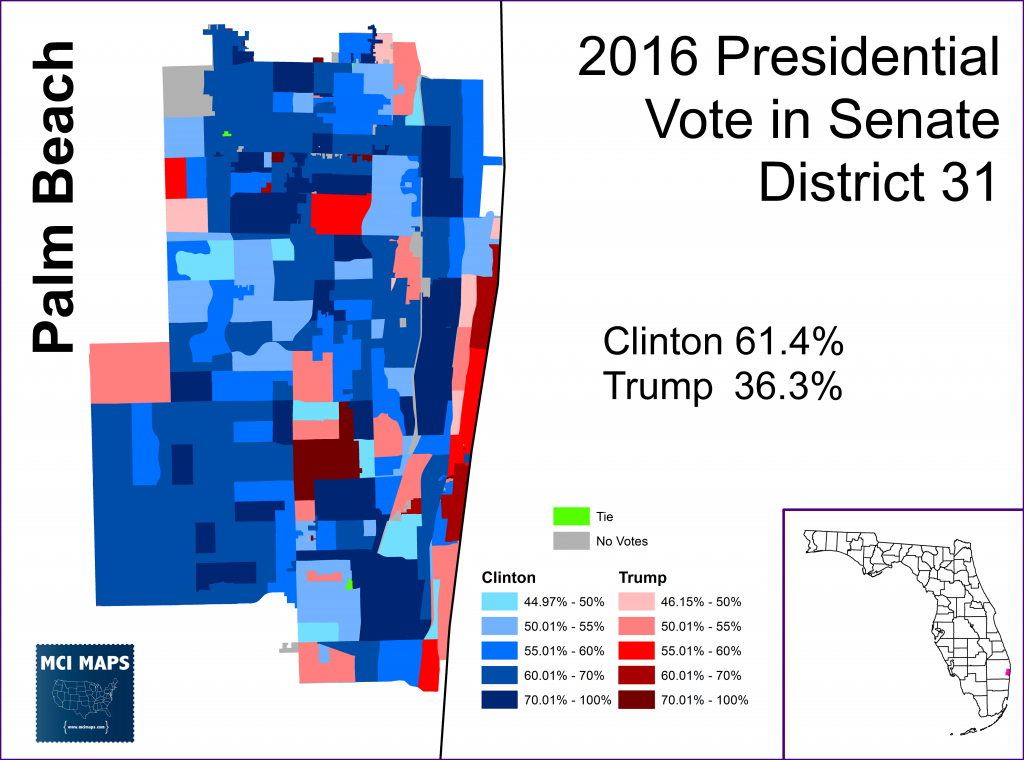
The district is currently represented by Lori Berman, who won a special election in 2018 with 75% of the vote. Berman’s lone opponent is Republican Tami Donnally, who hasn’t cracked $10,000 in fundraising yet. Berman is a lock for re-election.
Rating: Safe Democrat
State Senate District 33
Senate District 33, an African-American majority district in central Broward county, is represented by Democrat Perry Thurston. After easily winning his August primary, Thurston has no opponent in the general election.
Rating: Unopposed Democrat
State Senate District 35
The major battle for Senate District 35, an African-American majority district located in south Broward and north Miami-Dade, was the democratic primary. State Rep Shevrin Jones easily won a nasty, multi-candidate primary. Jones’ victory will make him the first LGBT state senator in Florida history – as well as the first LGBT State Senator of color.
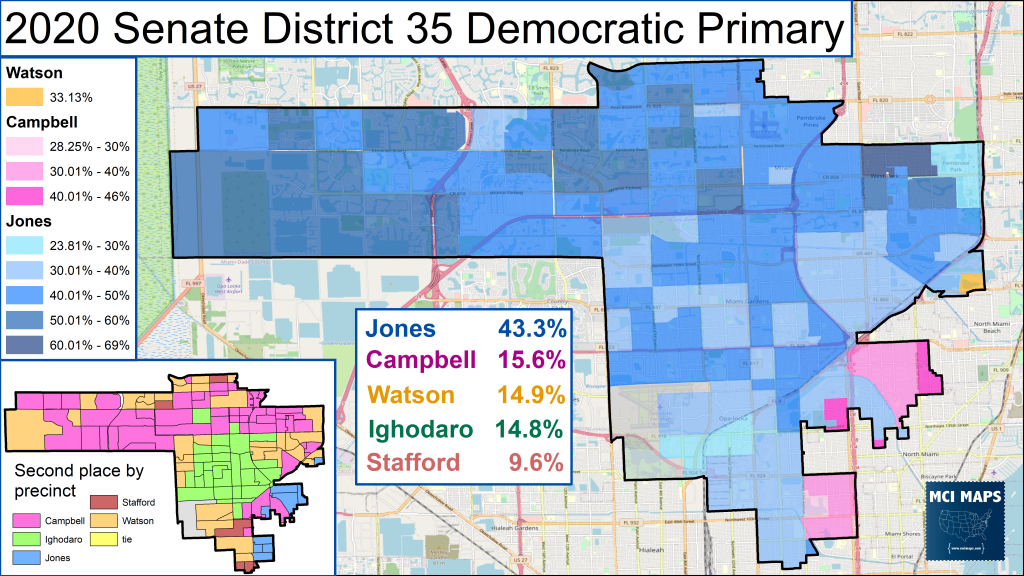
With the primary over, Jones only faces a write-in opponent for the general.
Rating: Safe Democrat
State Senate District 37
Two of Miami-Dade’s four Hispanic state senate seats are up this year. The first is SD37, which hugs the coast and includes Miami, Coral Gables, and Pinecrest. The district voted for Clinton by a 12%, and unlike other districts, it saw similar double digit margins for Democrats in the 2018 midterm.
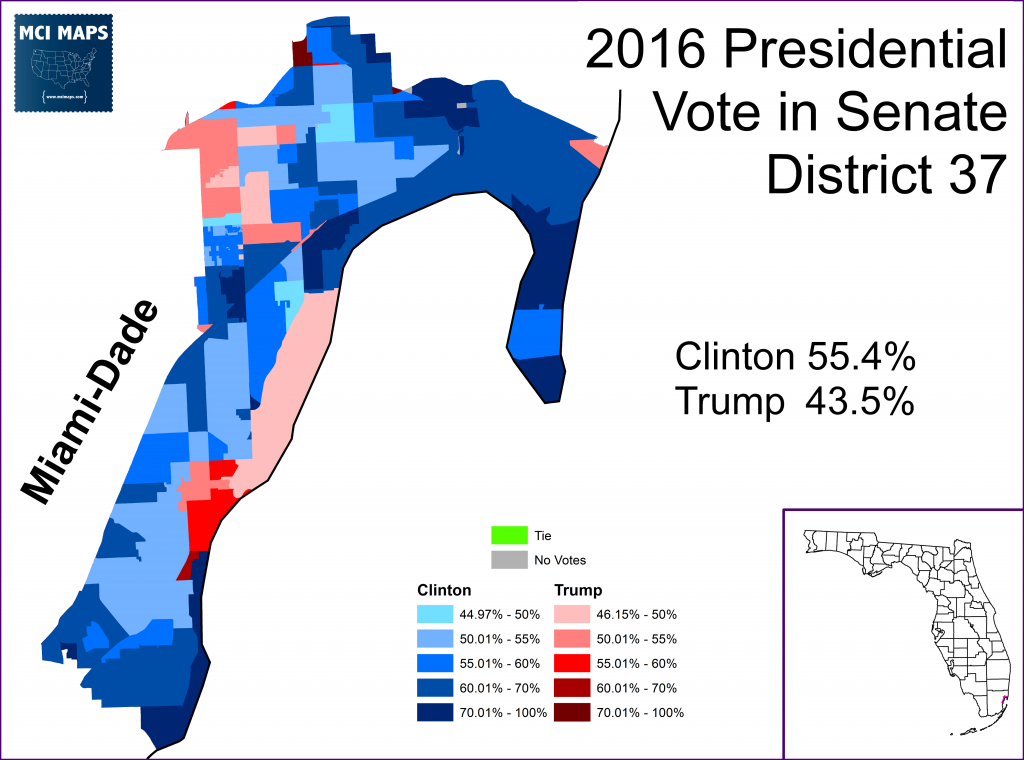
SD37 was a primary target in the 2016 election. HD112 State Rep Jose Javier Rodriguez (JJR) defeated incumbent Senator Miguel Diaz de la Portilla – a longtime politician from the powerful Cuban Portilla family.
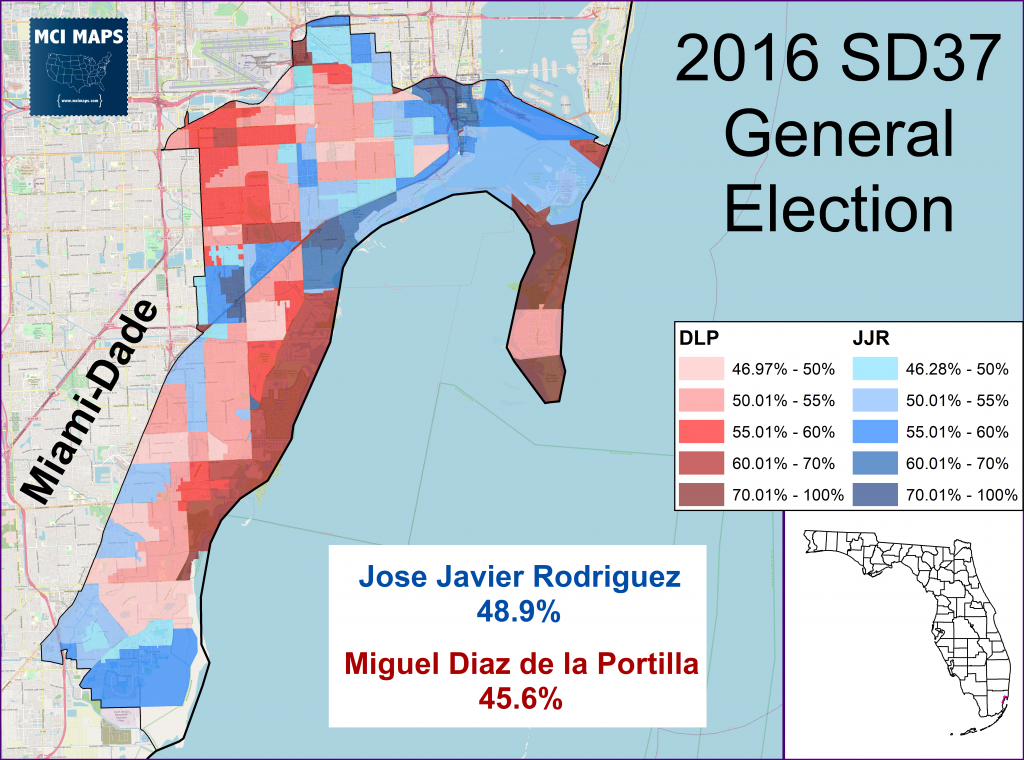
JJR’s win in 2016 made him a rising star in Democratic circles. He briefly considered running for the Florida 27th Congressional district, but to the relief of state democrats, he opted out. The Republicans are determined to not let him walk to re-election, but its not especially likely he will lose. The GOP nominee, Ileana Garcia, started out of with good fundraising, but the money has slowed to her official account; only taking in $88,000 (way too little for the Miami market). The GOP is flushed with cash however, and can always play in the district. However, JJR has raised over $500,000 and Democratic groups are not risking getting caught surprised here – making decided efforts to defend the seat and run a real campaign.
Overall, SD37 has moved more into Democratic columns, up and down the ballot. JJR can’t sleep walk to victory, but he’s clearly in the driver seat to re-election.
Rating: Likely Democratic
State Senate District 39
SD39 is the second Hispanic majority district to appear on the ballot this year, and it is the Democratic’s number 1 pick-up opportunity. Incumbent Anitere Flores is termed out from office, and a huge battle is about to take place in a district that backed Clinton by 10% but has a great deal of ticket splitting.
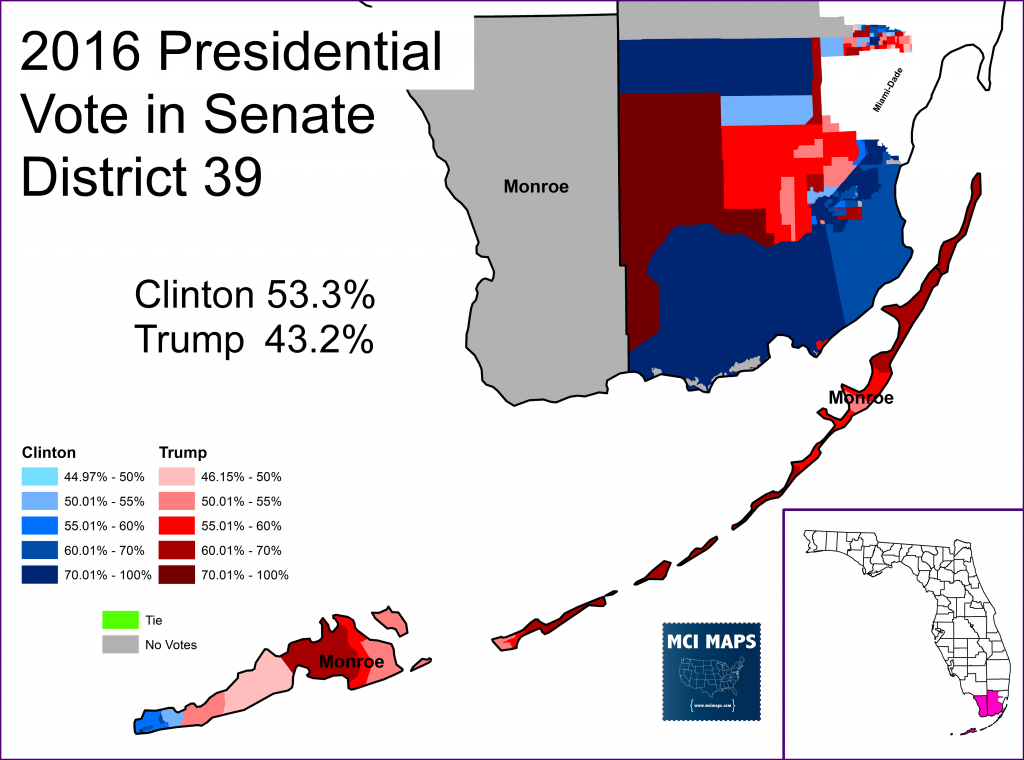
Officially the largest district by land mass (though SD3 wins that fight if you clip to the waterline) – SD39 has several key constituencies. The northern appendage is a decidedly Hispanic Cuban corridor and where Republicans see lots of down-ballot ticket splitting in their favor. South Dade includes areas like Homestead and Florida city – a much less Cuban area with more diverse Hispanics and African-Americans. The Florida Keys, meanwhile, are largely Republican until you get to Key West; which is consistently blue.
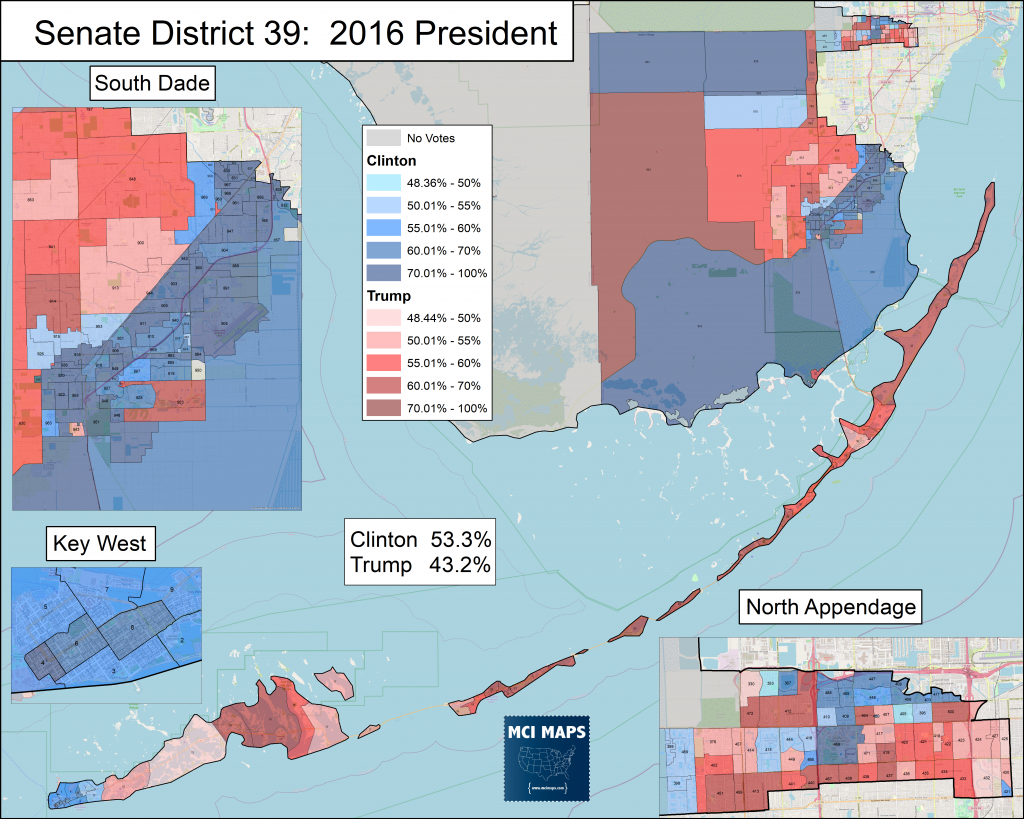
Both parties recruited state house members for this seat. Democrats recruited HD114 Rep Javier Fernandez while Republicans recruited HD 105 Rep Ana Maria Rodriguez. Both have raised huge money and outside spending is already high in this race. Democrats expect Biden to carry the district, even if there is a tightening with Cuban-aligned voters. In 2018, an election where Miami-Dade caused major problems for Democrats, Gillum, Nelson, and Fried still won the district by 3 points. Dueling polls have been floated out in recent days by both sides; each showing their respective candidates ahead. The answer to the dueling polls and the results from 2016 and 2018 is both a factor of ticket splitting, Cuban preferences, and turnout. Part of Democratic issues in Miami-Dade in 2018 was weaker non-Cuban Hispanic turnout and a stronger GOP-aligned Cuban voting share. For Democrats, getting their non-Cuban Hispanic base out is critical to countering what is likely to be a loss with Cuban voters. Of course, Democrats also hope that Fernandez’s Cuban heritage will help him with these voters (especially the non-exiles). In the end, the winner of this race (and how the top-of-the-ticket) performs could come down to what type of electorate is showing up.
Rating: Tossup
Rankings Conclusion
The Senate map this cycle is largely filled with safe districts for both parties. By far the most competitive are SD 9 and 39 – and these districts are key to Democratic futures in Florida.
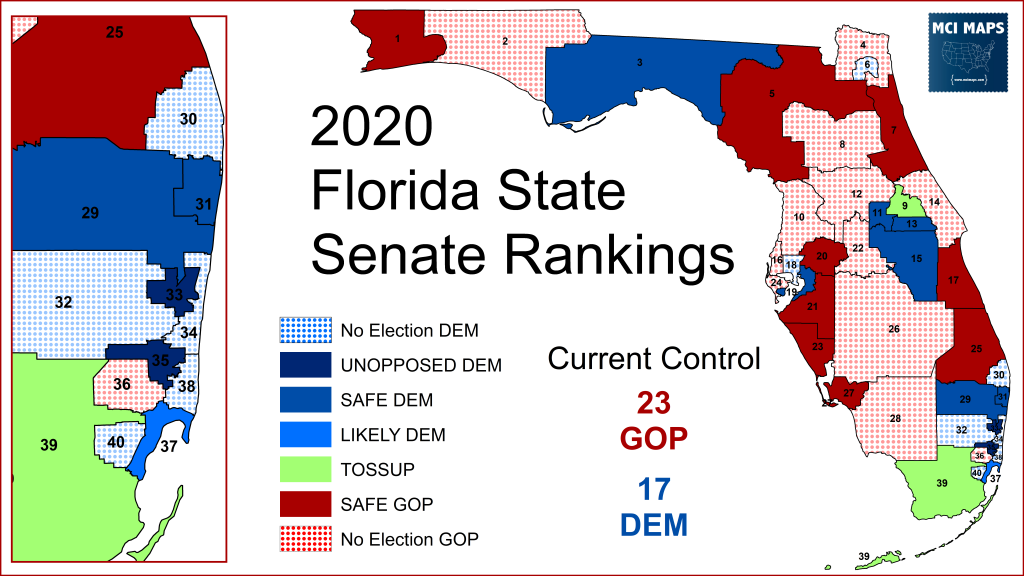
A 21-19 split in the senate is viewed as crucial for Democrats when it comes to redistricting – as it leaves the GOP with little room (there is no tie-breaking) and a caucus with its own competing factions. Unfortunately for the Democrats, the gap between a 19th seat and a 20th is still at least a cycle away. The plus side for Democrats is they have few defenses to truly worry about; with 3 and 37 being the lone districts they must at least keep an eye on.
2018 saw many more contentious senate elections. This time the map is much more narrower.

